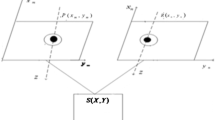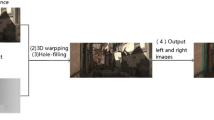Abstract
In this paper, we propose a simple anaglyph 3D stereo generation algorithm from 2D video sequence with a monocular camera. In our novel approach, we employ camera pose estimation method to directly generate stereoscopic 3D from 2D video without building depth map explicitly. Our cost-effective method is suitable for arbitrary real-world video sequence and produces smooth results. We use image stitching based on plane correspondence using fundamental matrix. To this end, we also demonstrate that correspondence plane image stitching based on Homography matrix only cannot generate a better result. Furthermore, we utilize the structure-from-motion (with fundamental matrix) based reconstructed camera pose model to accomplish visual anaglyph 3D illusion. The anaglyph result is visualized by a contour based yellow-blue 3D color code. The proposed approach demonstrates a very good performance for most of the video sequences in the user study.








Similar content being viewed by others
References
Azzari L, Battisti F, Gotchev A, Carli M, Egiazarian K (2011) A modified non-local mean inpainting technique for occlusion filling in depth-image-based rendering. In Pro. SPIE, Stereoscopic Displays and Applications XXII, volume 7863
Brown M, Lowe DG (2007) Automatic panoramic image stitching using invariant features. Int J Comput Vis 74(1):59–73
Do L, Zinger S, de With PHN (2011) Warping error analysis and reduction for depth- image-based rendering in 3dtv. In Pro. SPIE, Stereoscopic Displays and Applications XXII, volume 7863
Fradi H, Dugelay J (2011) Improved depth map estimation in stereo vision. In Pro. SPIE, Stereoscopic Displays and Applications XXII, volume 7863
Hartley RI (1999) Theory and practice of projective rectification. Int J Comput Vis 35(2):115–127
Hartley R, Zisserman A (2003) Multiple view geometry in computer vision. Cambridge University Press, New York
Kurz C, Thormählen T, Seidel H (2011) Bundle adjustment for stereoscopic 3d. In Proc. 5th int. conf. Computer vision/computer graphics collaboration techniques
Kutulakos KN, Vallino JR (1998) Calibration-free augmented reality. IEEE Trans Vis Comput Graph pages 1–20
Lepetit V, Fua P (2006) Keypoint recognition using randomized trees. IEEE Trans Pattern Anal Mach Intell 28(9):1465–1479
Loop C, Zhengyou Z (1999) Computing rectifying homographies for stereo vision. In IEEE Computer Vision and Pattern Recognition(CVPR), volume 1
Lowe DG (2004) Distinctive image features from scale-invariant keypoints. Int J Comput Vis 60(2):91–110
McKay HC (1951) Three-dimensional photography: principles of steroscopy. American Photography
Muja M, Lowe DG (2009) Fast approximate nearest neighbors with automatic algorithm configuration. In Proc. Int. Conf. . Computer Vision Theory and Application (VISSAPP’09), pages 331–340
Niquin C, Pevost S, Remion Y (2010) A point cloud based pipeline for depth reconstruction from autostereoscopic sets. In Pro. SPIE, Stereoscopic Displays and Applications XXI, volume 7524
Robertson DP, Cipolla R (2009) Structure from Motion. Practical Image Processing and Computer Vision, John Wiley
Shi R, Gan Y, Wang Y (2018) Evaluating scalability bottlenecks by workload extrapolation. In 2018 IEEE 26th International Symposium on Modelling, Analysis and Simulation of Computer and Telecommunication Systems (MASCOTS), Milwaukee, WI, USA, Sept
Spottiswoode R, Spottiswoode N (1993) The Theory of Stereoscopic Transmission & Its Application to the Motion Picture. Cambridge University Press
Torr PHS, Murray DW (1997) The development and comparison of robust methodsfor estimating the fundamental matrix. Int J Comput Vision pages 271–300
Yousefi S, Kondori F, Li H (2011) 3d gestural interaction for stereoscopic visualization on mobile devices. In 14 Computer Analysis of Images and Patterns (CAIP), pages 555–562
Zisserman A, Fitzgibbon A, Cross G (1999) Vhs to vrml: 3d graphical models from video sequences. In Pro. IEEE Int. Conf. Multimedia Computing and Systems - Volume 2
Acknowledgements
This research is supported by Shandong Provincial Natural Science Foundation (ZR2017QF015) and National Natural Science Foundation of China (No. 61902203).
Author information
Authors and Affiliations
Corresponding author
Additional information
Publisher’s note
Springer Nature remains neutral with regard to jurisdictional claims in published maps and institutional affiliations.
Rights and permissions
About this article
Cite this article
Lv, Z., ur Réhman, S., Khan, M.S.L. et al. An anaglyph 2D-3D stereoscopic video visualization approach. Multimed Tools Appl 79, 825–838 (2020). https://doi.org/10.1007/s11042-019-08172-1
Received:
Revised:
Accepted:
Published:
Issue Date:
DOI: https://doi.org/10.1007/s11042-019-08172-1




